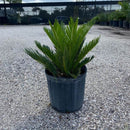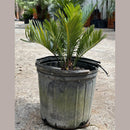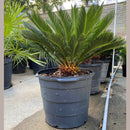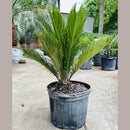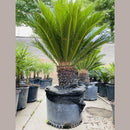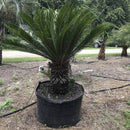| Grows Well In Zones: | 4-11 Patio / 8-11 Outdoors |
| Mature Height: |
4-6 ft Indoors 8-12 ft Outdoors |
| Mature Width: |
3-5 ft Indoors 6-8 ft Outdoors |
| Sunlight: | Indoors: Bright Indirect Light Outdoors: Full Sun to Partial Shade |
| Growth Rate: | Slow |
| Shape: | Tree |
| Placement: | Indoors, Patio, Outdoors |
Stunning cycad
Although Sago Palms resemble palm trees, they actually belong to the cycad family. The name Sago Palm comes from their similarity to palm trees; however, they are genetically closer to pine trees than palm trees!
Native to Japan and Southern China, Sago Palm Trees are remarkably resilient and among the oldest living plants on the planet. They are often referred to as “living fossils”, because they have existed for over 10 million years, with their genetic composition largely unchanged.
The Sago Palm is a low growing plant with a stout trunk and long, feathery leaves that resemble palm fronds. They have dark green arching leaves that form in a circular pattern from the center, giving the plant a tropical and exotic appearance. This is the reason why people refer to it as a Sago Palm tree- it looks like a compact adult palm.
King Sago Palm trees are slow growing, easy to maintain plants that thrive both as houseplants and when planted on the ground outdoors. They are often planted in containers and used as patio palms or indoor plants. They are very adaptable, and with proper care and suitable conditions, they can live up to 200 years.
The King Sago Palm reaches sizes of up to 10-12 feet when in hot-humid weather and planted on the ground. However, they are so slow growing it takes them up to 50 years to reach their mature height. Although they can grow up to 12 feet, they are usually found at average heights of 6-7 feet, and grow at a rate of 6-10 inches per year.
The tropical palm-like cycad makes an eye-catching specimen, accent plant, used along a border or highlighting an entryway. It also grows well in containers or as a houseplant. It is worth noting that Sago Palms are toxic to both animals and humans when ingested, especially the seed.
If you’re looking for an exotic looking evergreen plant with an architectural beauty, the Sago Palm is perfect for you.
Q: How big do Sago Palms get?
A: When outdoors and planted on the ground, Sago Palms can grow up to 12 feet. When indoors, they slowly reach heights of 4-6 feet.
Q: Are Sago Palms cold-hardy?
A: They are cold-hardy, but need to de brought indoors or covered if temperatures fall below 20° F. It outdoors, protect them with a burlap or frost cover.
Q: Are Sago Palms toxic to animals?
A: Yes, they are toxic to animals and humans so they need to be handled with caution.
Q: Are Sago Palms good houseplants?
A: Yes, they are fantastic houseplants, since they are slow growers and like indirect sunlight and humid environments.
1. Sunlight
Sago Palms grow best in bright indirect light, but they can tolerate partial shade as well, making them great indoor palms.
2. Water
- For the first month, water twice a week. After it is established, water once a week unless it rains.
- Watering needs to be thorough to make sure the bottom roots receive water at every watering.
- Space out watering sessions so the roots are able to dry.
- The amount of water needed per palm per watering session is equivalent to the volume of the planting hole that was dug for each palm. This amount may range from 2 gallons for small containerized material to 15 gallons for larger palms.
- Plants in a container need more constant watering than those planted on the ground.
- Overwatering or bad drainage can cause permanent damage to the roots over time.
- Placing mulch over the roots can help with water retention. Use caution not to allow the mulch to touch the base of the palm, otherwise it can cause rot.
Watering varies depending on the season and the outside temperature:
Winter: (60 degrees or less) no need to water, except for the first 30 days after installation.
Spring: (75 degrees or less) water palm once a week.
Beginning of Summer: (90 degrees or less) 2-3 times a week.
Heat of Summer: (90 degrees and above) 4 times a week.
3. Fertilization
If planted outdoors, Sago Palms should be fertilized when newly planted and then three times a year in the Spring, Summer and Fall. If planted indoors, it needs only Spring and Summer fertilization.
4. Soil
Palms tolerate most soils, as long as they drain well. Add coarse sand to the soil mix to help it drain better at a 70/30 soil to sand ratio.
5. Pruning
Prune only dead or damaged fronds. Avoid removing any green or yellow leaves, as they are still producing nutrients for the plant.
6. Winter Care
Sago Palms are considered cold-hardy. However, If temperatures fall below 20°F, it is best to bring them indoors or protect the leaves with a frost cover.
Customer Reviews
Payment & Security
Your payment information is processed securely. We do not store credit card details nor have access to your credit card information.
















